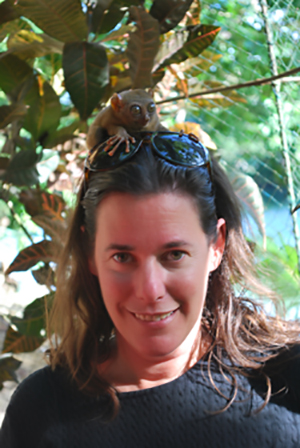Biography
Courses Taught:
- ANTH 201 – Introduction to Anthropology
- ANTH 205 – Peoples and Cultures of the World
- ANTH 225 – Introduction to Biological Anthropology
- ANTH 405 – Introduction to the Primates
- ANTH 489 – Primate Conservation
- ANTH 601 – Biological Anthropology
- ANTH 631 – Primate Behavioral Ecology
Current Graduate Students:
- Katie Hunter
- Alister Brown
- Grace Ann Peters
Research Interests
Specialty:
- Primate Behavioral Ecology and Conservation
Current Research Projects:
I am presently studying anthropogenic disturbances to nocturnal primates. An anthropogenic disturbance that is rarely addressed for nonhuman primates is the effect of artificial light at night (ALAN) which is defined by the spread of artificial lighting at night which eliminates natural darkness. Artificial light at night can result from streetlights, or indirectly from sky glow (artificial light that is scattered and reflected back to earth by the atmosphere). Research has demonstrated that artificial lighting causes changes in animal behavior, reproductive success, survivorship, as well as can alter the composition of the communities. The goal of this research project is to explore how the behavior of spectral tarsiers, Tarsius spectrum, is modified in response to artificial light. This study will be conducted at Tangkoko Nature Reserve on the easternmost tip of the northern arm of Sulawesi.
Educational Background
- PhD, SUNY Stony Brook, 1997
Selected Publications
-
Gursky, S. (2024). The effect of artificial light at night on a nocturnal primate. Folia Primatologica 1-14.
-
Syahrullah F., Maddus U., Mustari A., Gursky S. and Indrawan M. (2023). Distribution and Abundance of Peleng Tarsiers (Tarsius pelengensis) in Banggai Island group, Indonesia. Scientific Reports.
-
Gursky, S., Supriatna J., and Achorn, A. (2022). Ecotourism and Indonesia’s Primates. Springer Press.
-
Gursky, S. (2022). The effect of ecotourism on the spectral tarsier. In: Ecotourism and Indonesia’s Primates (ed. Gursky, Achorn and Supriatna). Springer nocturnal primate.
-
Hagerman L., Grow N., Bohr, Y., Farajallah D., Duma Y., Gursky S. and Merker S. (2022). Small, odd and old: The mysterious Tarsius pumilus is the most basal Sulawesi tarsier. Biology Letters 18:1-6.
-
Marsh, Sica, Upham, Jetz and Gursky et al. (2022). Global geographic range maps for mammals harmonized to three taxonomic authorities. Journal of biogeography49:979-992
-
Gursky S. and Mochamad Indrawan (2022) Taxonomy of Peleng Tarsiers in Imperiled: The Encyclopedia of Conservation (DellaSala D and Goldstein M, eds). Elsevier.
-
Shekelle M., Gursky S., Achorn A. (2022). Chapter 6: Tarsiiformes. In: The Natural History of Primates: A Systematic Survey of Ecology and Behavior (Sussman R, Hart D, and Colquhoun I, eds.). Rowan and Littlefield Press.
-

